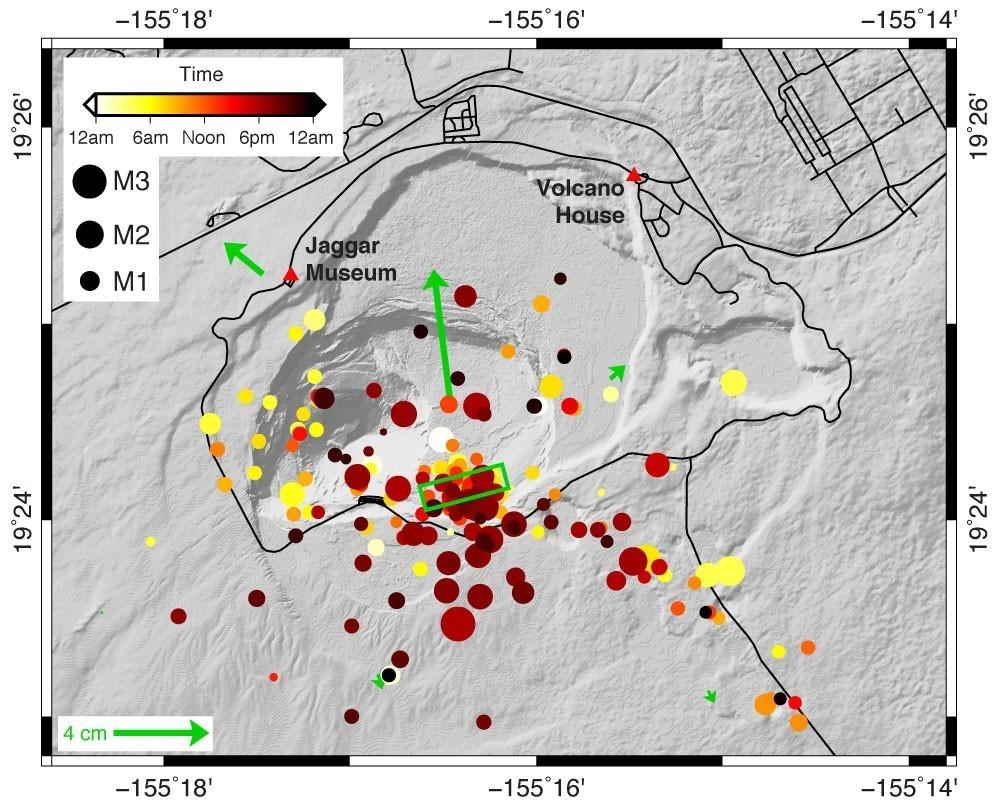Volcano Watch: A Small But Notable Magma Intrusion at Kīlauea’s Summit
By US Geological Survey Hawaiian Volcano Observatory scientists and affiliates. Article by HVO research geophysicist Ingrid Johanson.
The 2018 lower East Rift Zone eruption and summit caldera collapse marked the end of the 35-year-long Puʻu ʻŌʻō and 10-year-long summit lava lake eruptions, and the beginning of a new chapter in Kīlauea Volcano activity. The volcano is continuing to behave in ways that are a response to the major events of 2018 and “the new normal” is yet to be defined.
The range of possibilities for future events at Kīlauea is wide open and any new post-eruption observation sparks investigation as we work to better understand

Map showing locations of earthquakes at Kīlauea’s summit on December 2, 2020. Motion detected by HVO’s GPS monitoring network is shown as green arrows. The length of the arrow corresponds to the amount of motion and the direction it points shows the direction of motion. Earthquakes are plotted as circles with color corresponding to the time of day they occurred, and size scaled according to earthquake magnitude. The green box shows the minimum size of the magma intrusion, as constrained by ground deformation. The intrusion model shows opening of a rectangular surface with its top edge to the south-southeast that trends downward to the north-northeast at an angle of 40–60 degrees. Black lines are local roads. (Public domain.)
One such observation was the first post-eruption detection of a summit Deflation-Inflation event (DI-event) in late 2018. The return of DI-events was a clue that the shallow Halemaʻumaʻu
Recently, the USGS Hawaiian Volcano Observatory’s (HVO)
During the early
Both the swarms and pattern of ground deformation were consistent with a small dike intrusion under the southern part of Kīlauea
Intrusions have been recorded at Kīlauea’s summit many times. A notable recent occurrence was in May 2015, when inflation of Kīlauea’s shallow
Preliminary models suggest
In 1974, earthquake swarms in the upper East Rift Zone and southern portion of Kīlauea caldera, as well as changes in summit tilt, preceded an eruption from Keanakākoʻi Crater by about 10 hours. The 1974 eruption produced lava fountains up to 30 m (100 feet) high and sent lava flowing into Kīlauea caldera. The eruption also opened fissures near Luamanu Crater that sent a lava flow over Chain of Craters Road.
This scenario was in the minds of HVO scientists as the events of December 2 unfolded and an overnight watch was established to closely monitor data feeds. However, as the HVO Information Statement on Dec. 3 indicated, earthquake rates
Though small, this intrusion is a reminder that Kīlauea can still be considered one of the most active volcanoes on earth and that the next eruption from Kīlauea Volcano is just a matter of time. We are still encountering new “firsts” in the post-2018 regime that lead us toward a better understanding of this new period of activity. HVO, as always, keeps a close eye on monitoring data for any changes, big or small.
Volcano Activity Updates
Kīlauea Volcano is not erupting. Its USGS Volcano Alert level remains at NORMAL. Kīlauea updates are issued monthly.
Kīlauea monitoring data for the past month show variable rates of seismicity and ground deformation, low rates of sulfur dioxide emissions, and only minor geologic changes since the end of eruptive activity in September 2018. A Kīlauea Information Statement on Dec. 3 summarized increased seismicity beneath the summit during Nov. 29–Dec. 3. Ground deformation rates accompanying the seismicity
Mauna Loa is not erupting and remains at Volcano Alert Level ADVISORY. This alert level does not mean that an eruption is imminent or that progression to eruption from current level of unrest is certain. Mauna Loa updates are issued weekly.
This past week, about 113 small-magnitude earthquakes were recorded beneath the upper-elevations of Mauna Loa; most of these occurred at depths of less than 8 kilometers (about 5 miles). Slightly increased earthquake activity continues on Mauna Loa’s northwest flank, which began on December 4, 2020. In the past week, HVO has recorded 98 earthquakes in this region. Earthquake swarms in this region have occurred previously in October 2018, April 2017, July 2016, August 2015 and earlier, and do not indicate that an eruption is imminent. Global Positioning System measurements show long-term slowly increasing summit inflation, consistent with magma supply to the volcano’s shallow storage system. Gas concentrations and fumarole temperatures as measured at both Sulphur Cone and the summit remain stable. Webcams show no changes to the landscape.
There were 3 events with 3 or more felt reports in the Hawaiian Islands during the past week: a M1.7 earthquake 11 km (6 mi) E of Pāhala at 31 km (19 mi) depth on Dec. 14 at 7:38 p.m. HST, a M2.2 earthquake 18 km (11 mi) SSE of Waimea at 21 km (13 mi) depth on Dec. 14 at 10:40 a.m. HST, and a M4.4 earthquake 20 km (12 mi) SSE of Waimea at 24 km (15 mi) depth on Dec. 14 at 09:27 a.m. HST.
HVO continues to closely monitor both Kīlauea and Mauna Loa for any signs of increased activity.
Volcano Watch is a weekly article and activity update written by US Geological Survey Hawaiian Volcano Observatory scientists and affiliates.









